There’s a particular romance to a 30-something striker being in the form of their career.
Forwards typically peak slightly later than other outfield positions, which have greater physical demands, and goalscoring does involve wisdom (which comes with age), but the peak age for strikers is 27.
Nottingham Forest’s Chris Wood turns 33 next month. He is joint second-top goalscorer in the 2024-25 Premier League with Brentford’s Bryan Mbeumo on eight.
Wood is something of a late bloomer, having been sent out on five different loans while he was at West Bromwich Albion, the New Zealander’s first English club. It wasn’t until he turned 25, with Burnley in 2017-18, that he became a Premier League regular.
Last season — his first complete one with Forest after signing from Newcastle United in January 2023 — was his joint-best for Premier League goals (14, with no penalties, tied with 2018-19 — when he scored one penalty). It was the fifth time he’d got to double figures in a season in England’s top flight.
(Michael Regan/Getty Images)
Wood’s scoring rate in 2024-25 (one every 99 minutes) amounts to over 30 goals if he were to play every minute this season. Since Nuno Espirito Santo’s arrival as head coach last December, he ranks third among all Premier League players for goals.
Premier League goals since 2023-24
| Player | Goals | Club |
|---|---|---|
|
Erling Haaland |
24 |
|
|
Cole Palmer |
23 |
|
|
Chris Wood |
19 |
|
|
Alexander Isak |
17 |
|
|
Jean-Phillipe Mateta |
17 |
He is on a hot streak now, with Wood tied in second (alongside Ipswich Town’s Liam Delap) for goals scored above expected goals (+3.5) this season.
But it’s not like the guy is scoring 30-yard screamers every week. Most of his finishes are close to the goal, but also in space.
For a 6ft 3in (191cm) target man, Wood rarely scores by getting on top of defenders at crosses (think Aleksandar Mitrovic in his Fulham days). The last time he scored a header under pressure was in August 2023, a match-winner at home to Sheffield United.
Since the start of that 2023-24 season, of players with 50-plus Premier League shots, Wood has the highest proportion of one-touch shots (79.7 per cent). Eight of his 21 goals have been headers — only Ollie Watkins of Aston Villa can match that.

From Wood’s 69 shots, 27 have been “clear” chances. Opta defines these as attempts where there are no defenders between the shooter and the goal, or in close proximity. At 38 per cent, Wood takes the highest proportion of “clear” shots in the Premier League.
His secret? Wood is excellent at being offside.
Only Everton’s Dominic Calvert-Lewin (16) has been offside in the Premier League more this season (it’s 11 for Wood), but it is how the Forest striker positions himself during the build-up which is important. His touchmaps show he doesn’t drift wide much, operating as a lone striker at the top of a 4-2-3-1 — a focal point for Morgan Gibbs-White, the No 10, and the wingers. Wood does his work in the penalty area.

He rarely drops in, instead taking up positions behind the opposition centre-backs.
Here, against West Ham, as Gibbs-White plays a through ball to advancing left-back Alex Moreno, Wood stays in the blind spot of Jean-Clair Todibo and Maximilian Kilman.
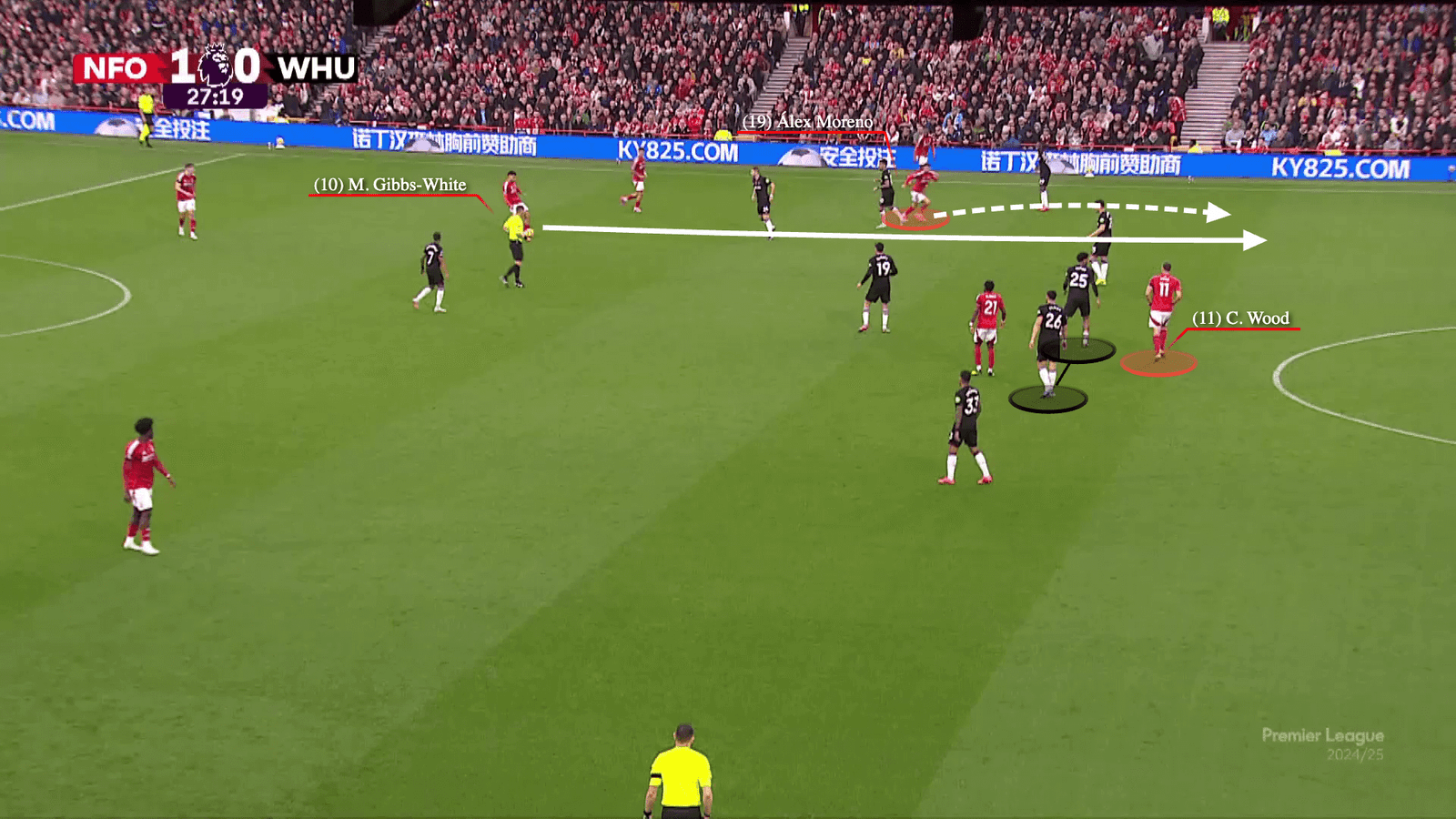
His first run is on an arc, across Tobido, should Moreno play an early cross. When that ball doesn’t come and Todibo recovers, Wood checks back, then immediately darts forward again.
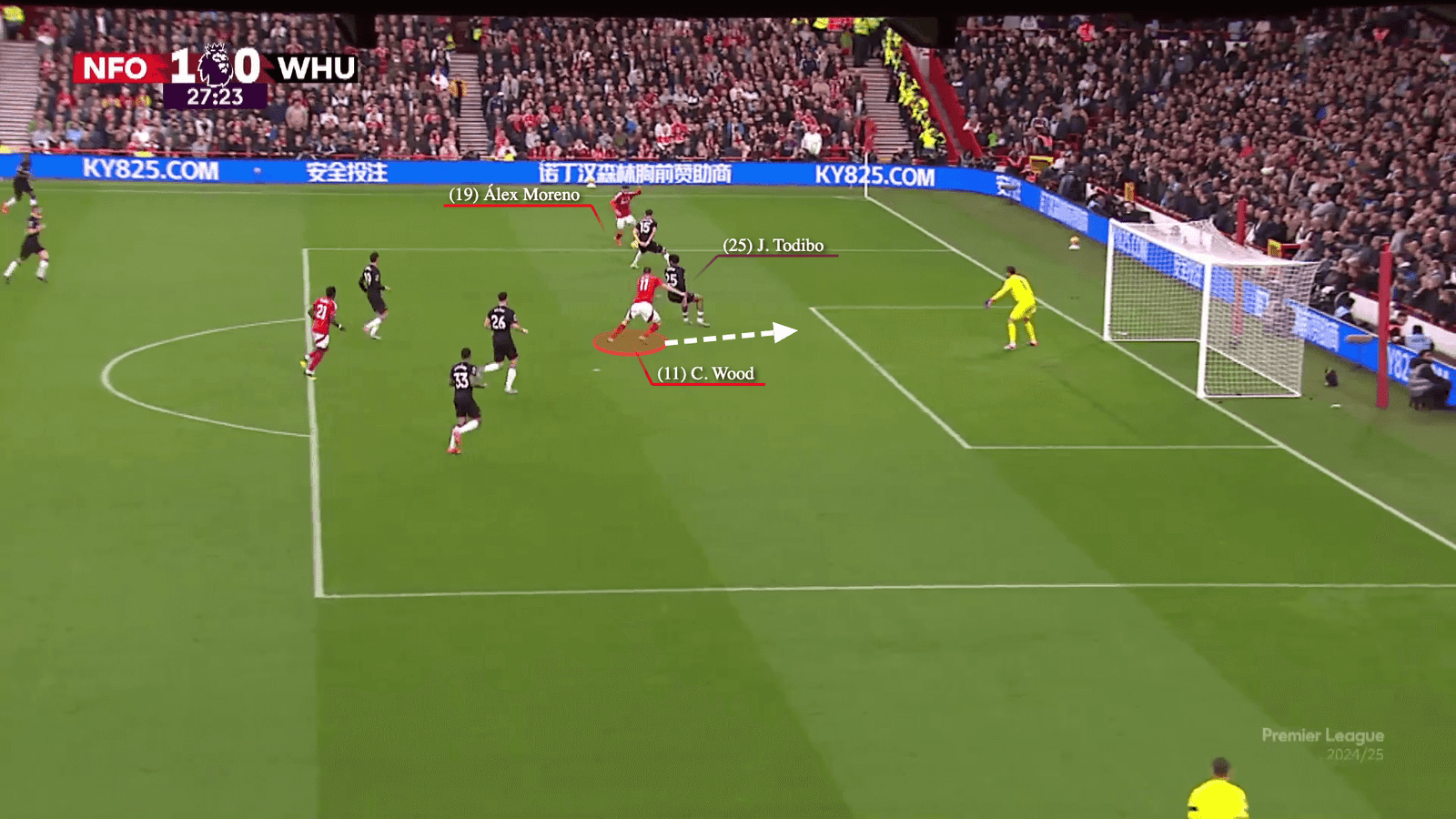
He makes sure he stays in-line with the ball (to not be offside), and his varied movement, while staying behind Todibo, means the centre-back loses him and ends up ball-watching. Wood stands still, Moreno whips a cross onto his head, and he nods in the opener.
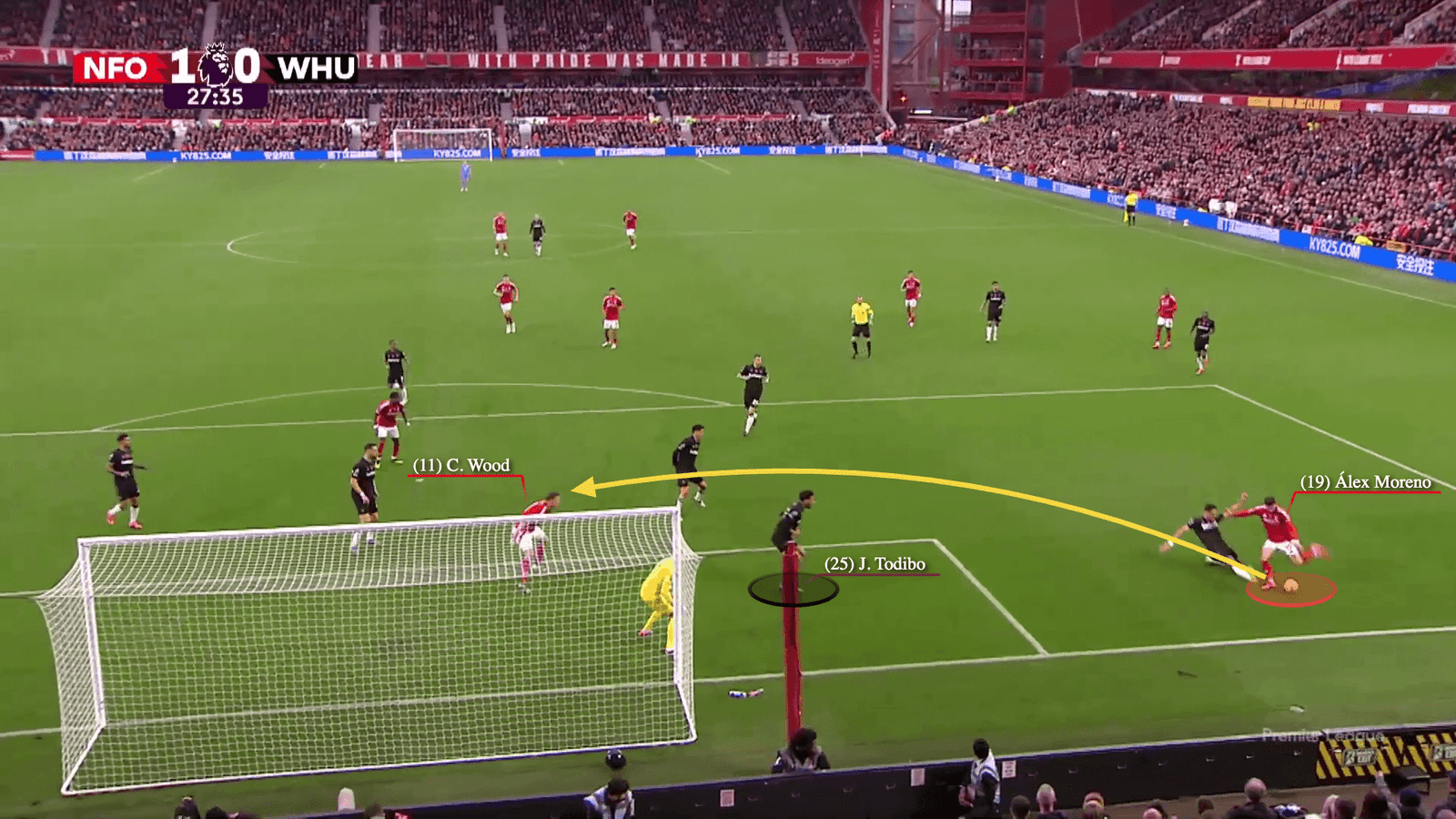
A different example with the same positioning can be found for the third goal of his hat-trick away to Newcastle last December.
Wood starts offside, behind marker Sven Botman, as Forest centre-back Murillo steps out with the ball.
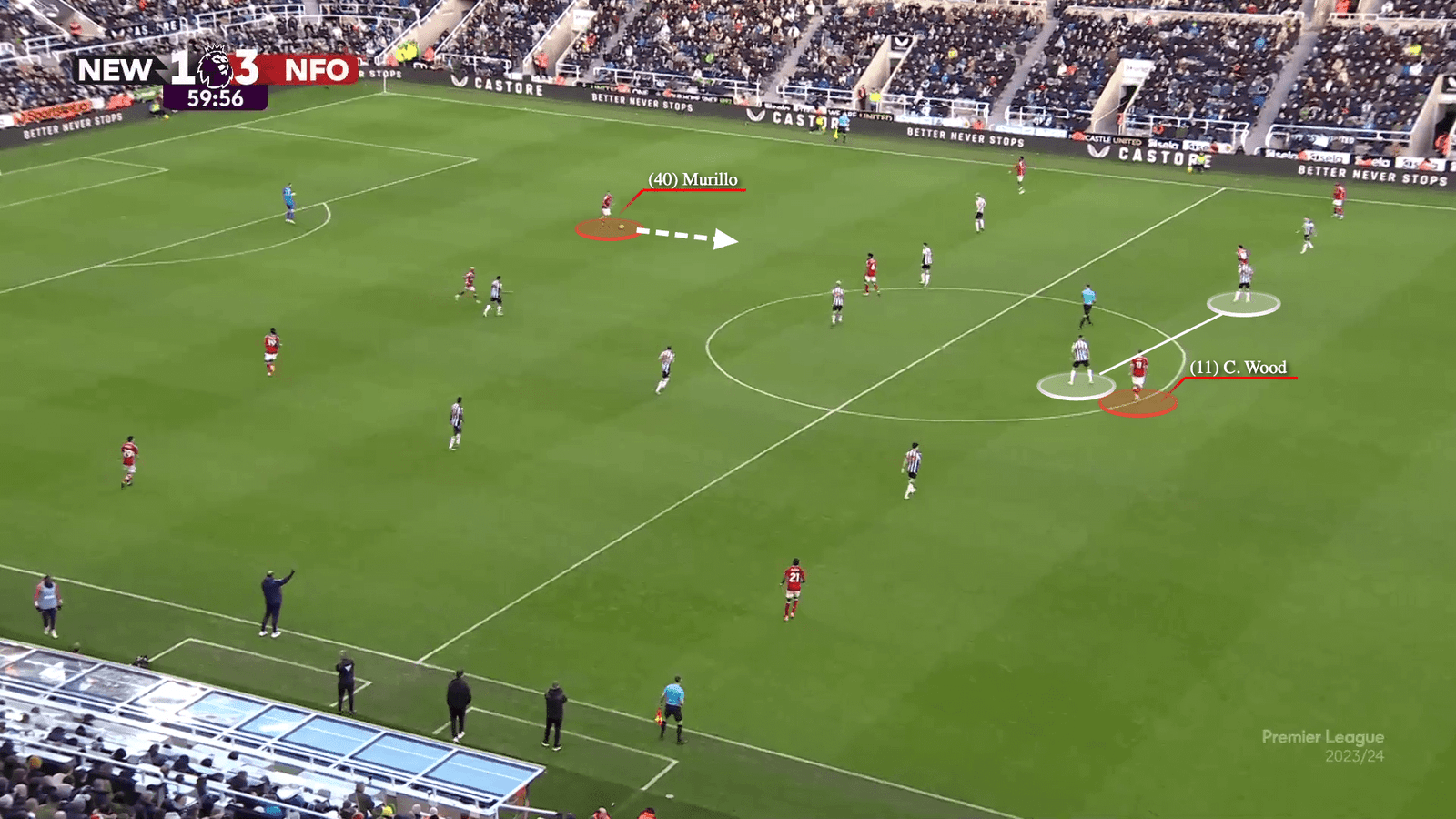
With no pressure and a high line from Newcastle in their mid-block, Murillo shapes to play a ball in-behind.
Wood arcs his run, initially towards the opposition centre-backs, before spinning away. Right-back Kieran Trippier has dropped off, keeping Wood onside. The striker goes through one-v-one, rounds goalkeeper Nick Pope, and taps in.

Here, before the first of his two goals away at Leicester City (another of his former clubs) late last month, Wood remains offside after a Forest attack breaks down and they then make a counter-press regain in the opposition half.
As Callum Hudson-Odoi works it inside to midfielder Elliot Anderson, Wood holds his position and lets the Leicester back four drop behind him.
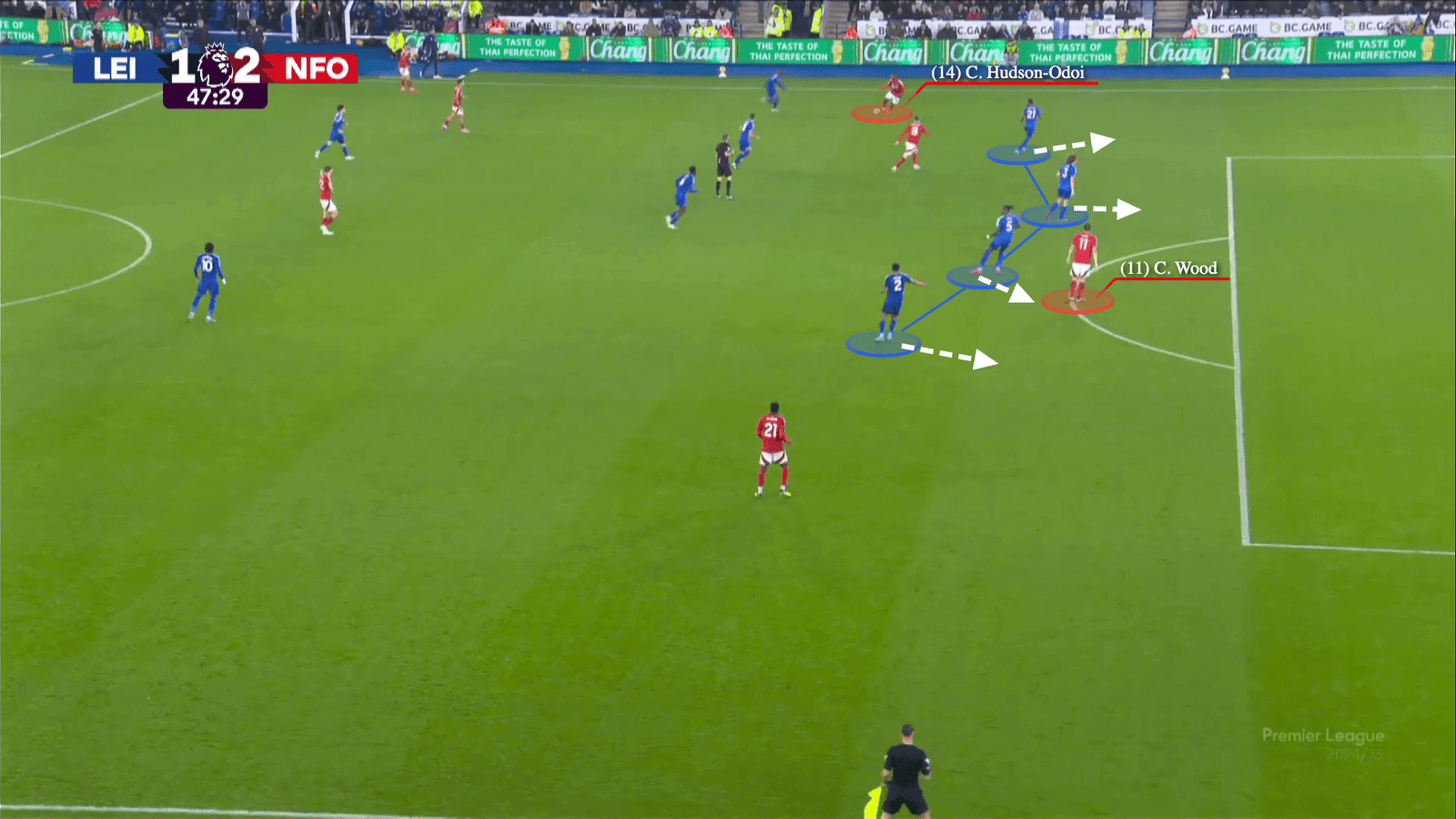
As the some side’s left centre-back Caleb Okoli retreats, Wood takes a few steps forwards, then darts across the box, as Anderson is in a cutback position.
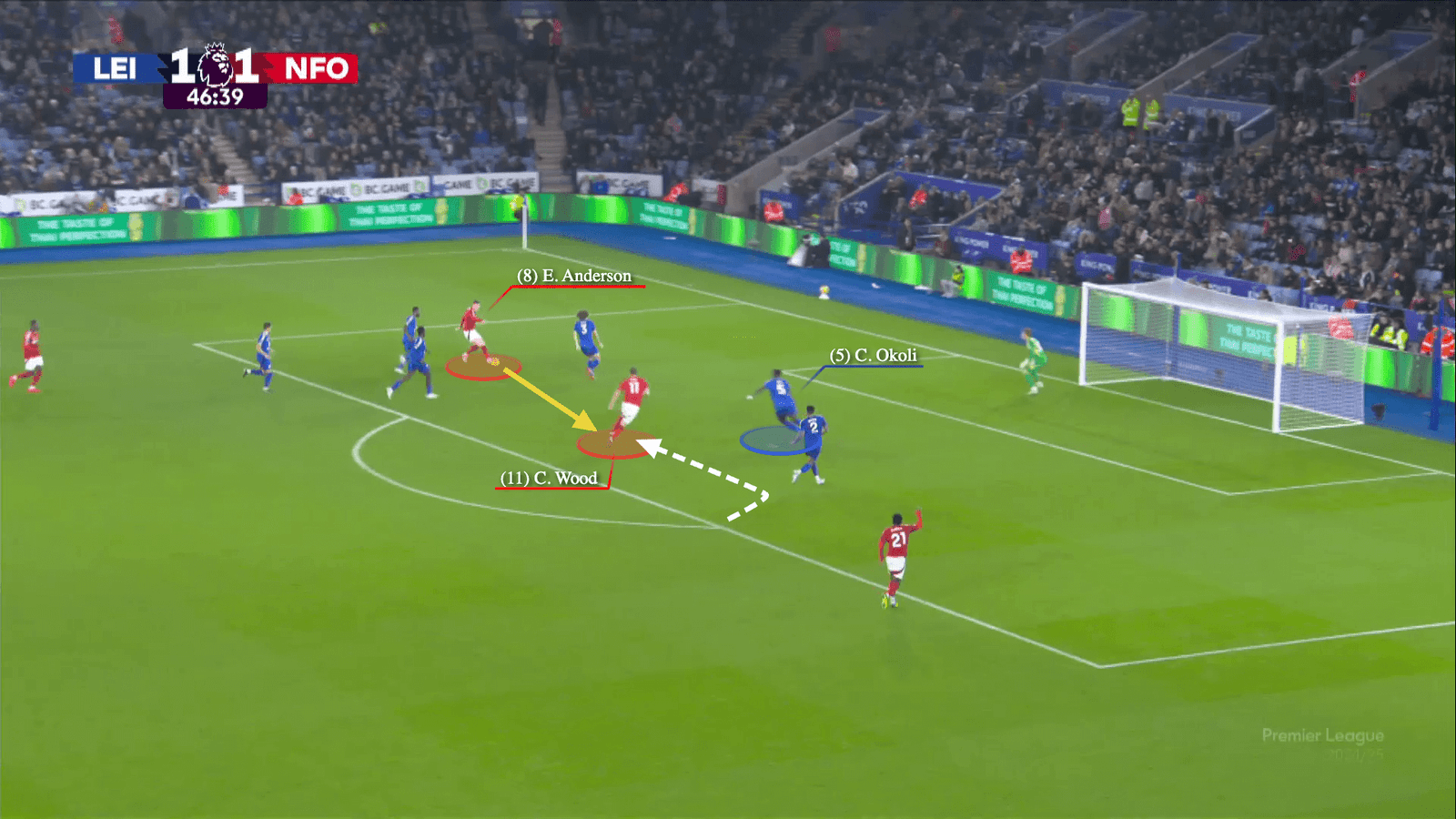
He takes the pass on his back (left) foot, turns, using his arms to hold Okoli off, and curls a shot with his right boot into the far corner.
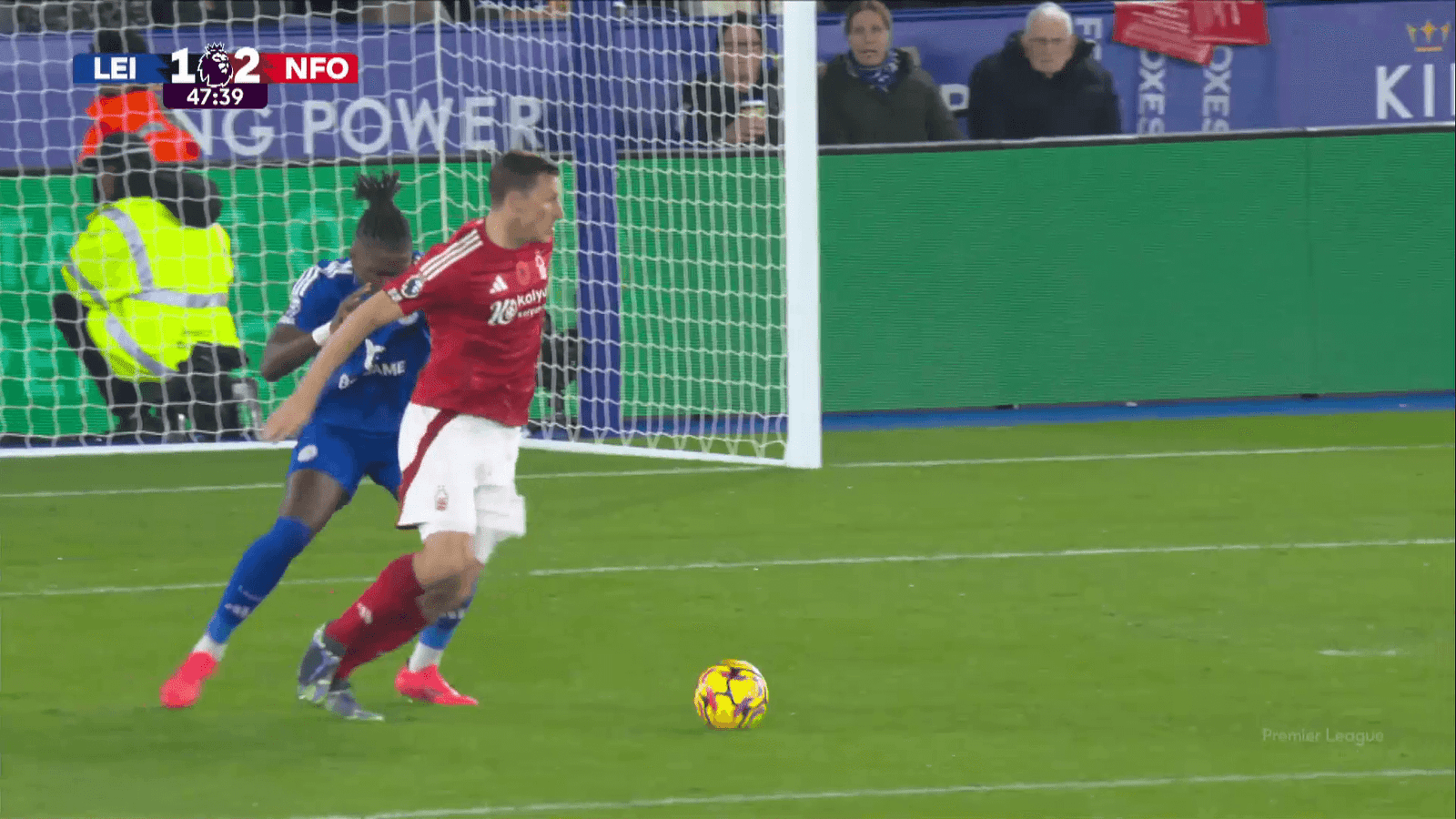
Speaking to former Premier League striker Glenn Murray on Nottingham Forest’s YouTube channel last week, Wood said that physicality and grappling with defenders is “a part of my game I’ve always had to work on. People who have it naturally are very gifted with it”.
That might sound surprising considering Wood’s size — he says he and Erling Haaland have very different styles despite their similar body types — but it is shown in his movement. He makes similar runs to an NFL wide receiver, with curves and zig-zags to get separation from defenders, timing his approach to crosses so he can finish with one touch.
For example, his equaliser at Brentford in an eventual 3-2 defeat in January this year. The chance comes from a counter-press regain once more, this time following a Forest throw-in by the corner flag. Wood had been the target for that but he lost the aerial duel to Ben Mee.
As Danilo picks up the ball on the edge of the final third, Wood is a) walking and b) offside.
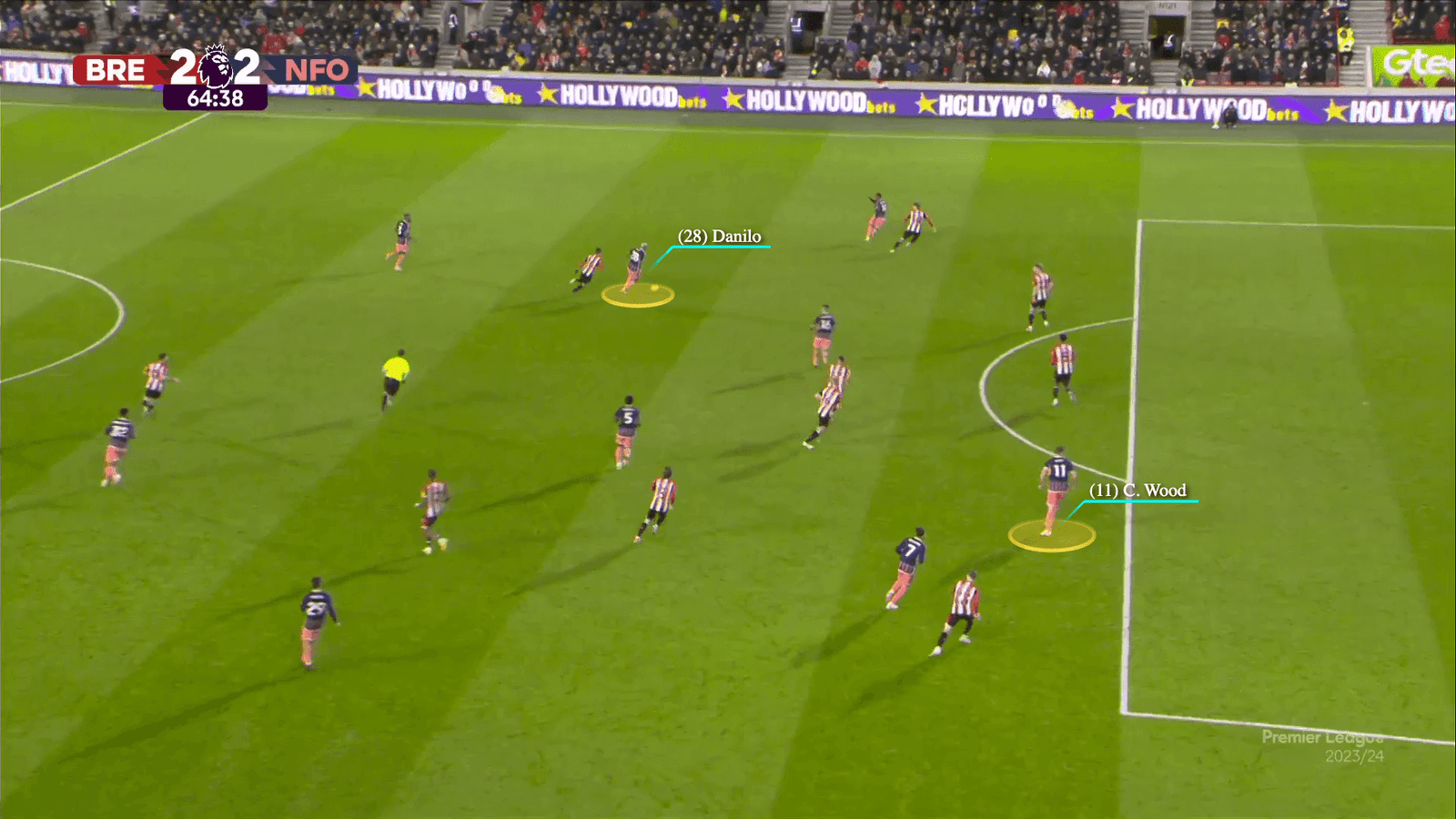
But as Mee recovers his place in the centre of defence and the ball is worked out to Hudson-Odoi, Wood makes an S-shaped run, going away from Mee and then around the penalty spot to match the trajectory of Hudson-Odoi’s inswinger — before glancing a header past Mark Flekken into the far corner.
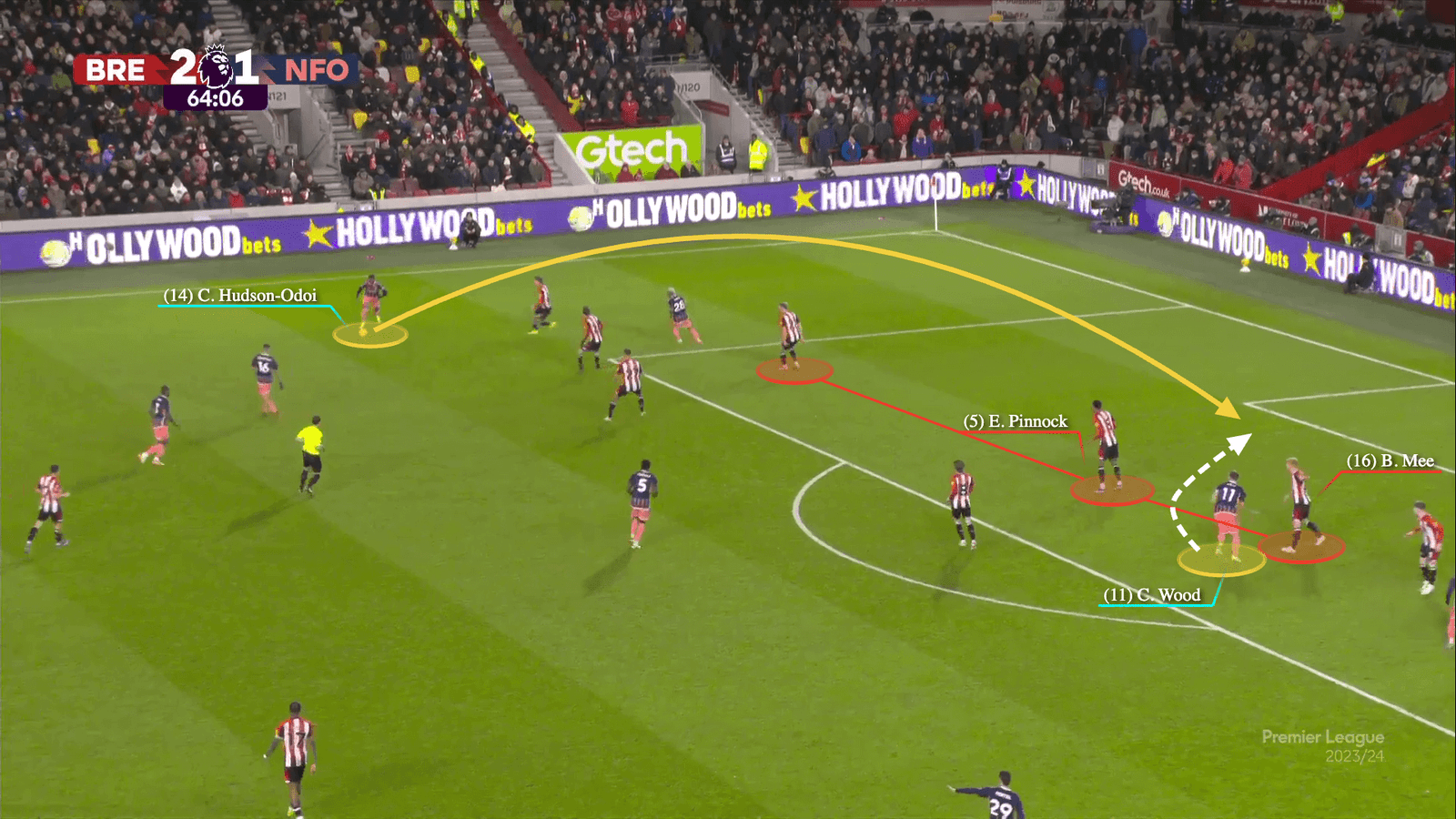
“I wouldn’t be anything without my team-mates,” Wood said to UK broadcaster Sky Sports after that brace at Leicester. “I’m not one that can take on four players and put it in the top corner. I rely on my service, and they’re delivering.”
The best example of this was away at Burnley on the final weekend of last season.
He stays in the blind spot of the far-side centre-back as Forest progress play down the right. Anthony Elanga, in a one-v-one against Charlie Taylor, dribbles at the home full-back and then goes on his outside.

Wood holds his run, then makes a burst to the back post to tap in.

Elanga set up Wood to score six times last season, the most prolific assister-goalscorer combination in the division.
Since the start of 2023-24, Wood has scored 34.9 per cent of Forest’s goals, the highest proportion of any player at any Premier League team — they play a system which is set up around him, and is maximising the strengths of its four forwards. “He’s (Nuno) put emphasis on getting balls in the box, people in the box, that supplies T (fellow striker Taiwo Awoniyi) and I extremely well,” he also told Sky Sports after the Leicester match.
After all, this is how Wood has played throughout his senior career, scoring 10 goals in four consecutive Premier League seasons, under Sean Dyche, for Burnley between 2017-18 and 2020-21. There, he had the crossing of Dwight McNeil (four assists for Wood in 2018-19), and benefited from a direct attacking style mixed with a more passive defensive approach which reduced the physical demands on him out of possession.
In the past five-and-a-bit seasons, Wood’s average shot distance has only once (13 yards in 2022-23) been further out than the penalty spot. He’s a quality over quantity shooter.
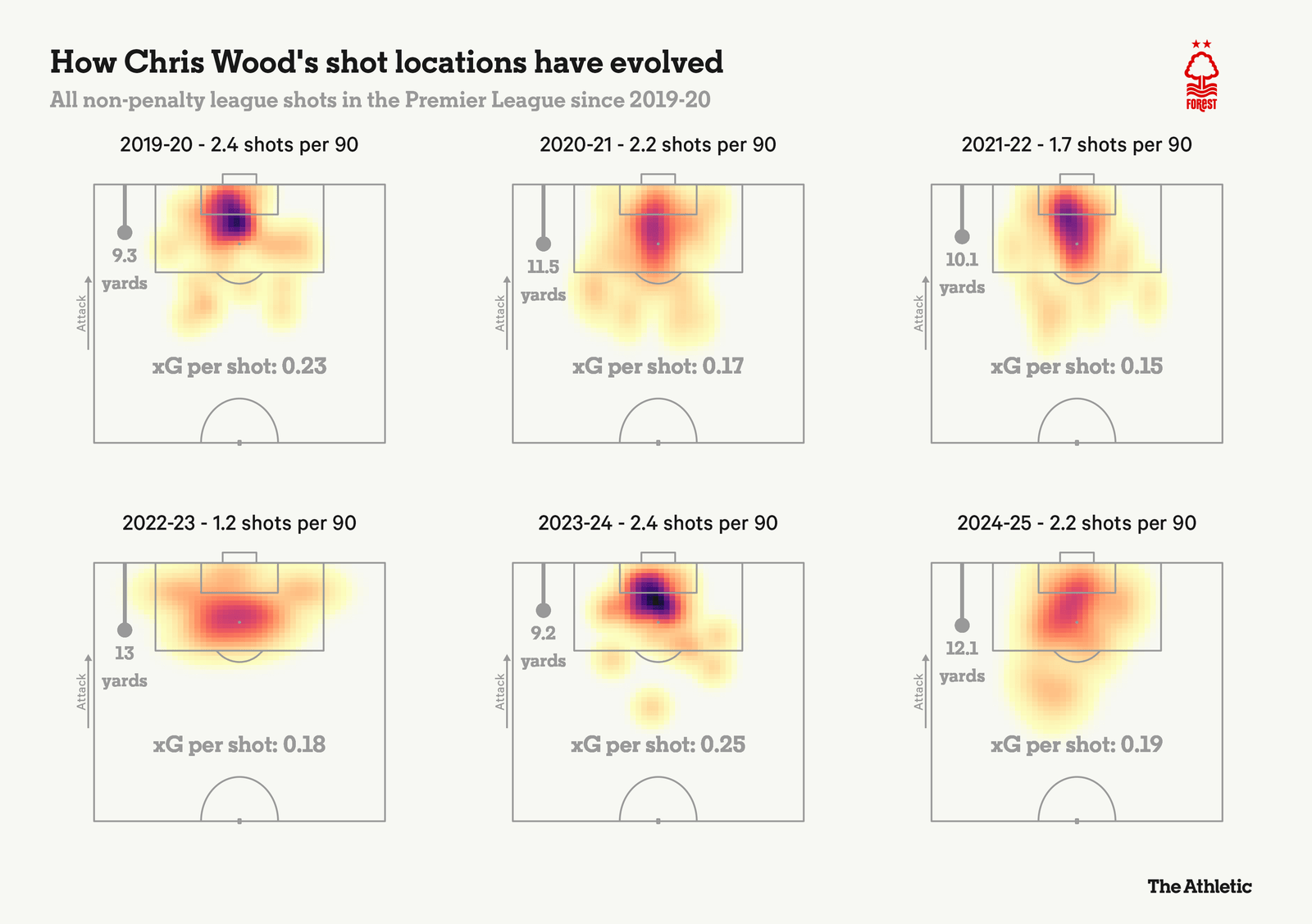
Pundit Gary Neville, on Sky Sports, asked Wood about the return of the target man-type No 9 after he scored those two goals against Leicester. “We want to try and bring it back, or I’ll be out of a job,” he joked.
As Murray once said, “the goalposts don’t move” between the game’s various divisions, nor as a player gets older. The likes of Jamie Vardy at Leicester and Brighton’s Danny Welbeck have shown that goalscoring is an art and that players can improve with age, although they are two strikers who primarily play off the shoulder.
This is a real third peak for Wood in his career, firstly with Leeds United in the second-tier Championship in his early twenties, then at Burnley in his late twenties, and now at Forest well into his thirties. Notably, with strikers who do peak that late, it is often a result of a role change (from wide forward to No 9) and moving abroad to play in a weaker competition.
That makes it all the more impressive — and romantic — that Wood is managing this without really changing his game, and doing it in Europe’s biggest league, too.
The season probably won’t end with him winning the Golden Boot, and Forest fans should enjoy their team being in third place while it lasts, but Wood’s form serves as an important reminder that you’re never too old to score goals — you’ve just got to be wiser.
(Top photo: Michael Regan/Getty Images)
Read the full article here


